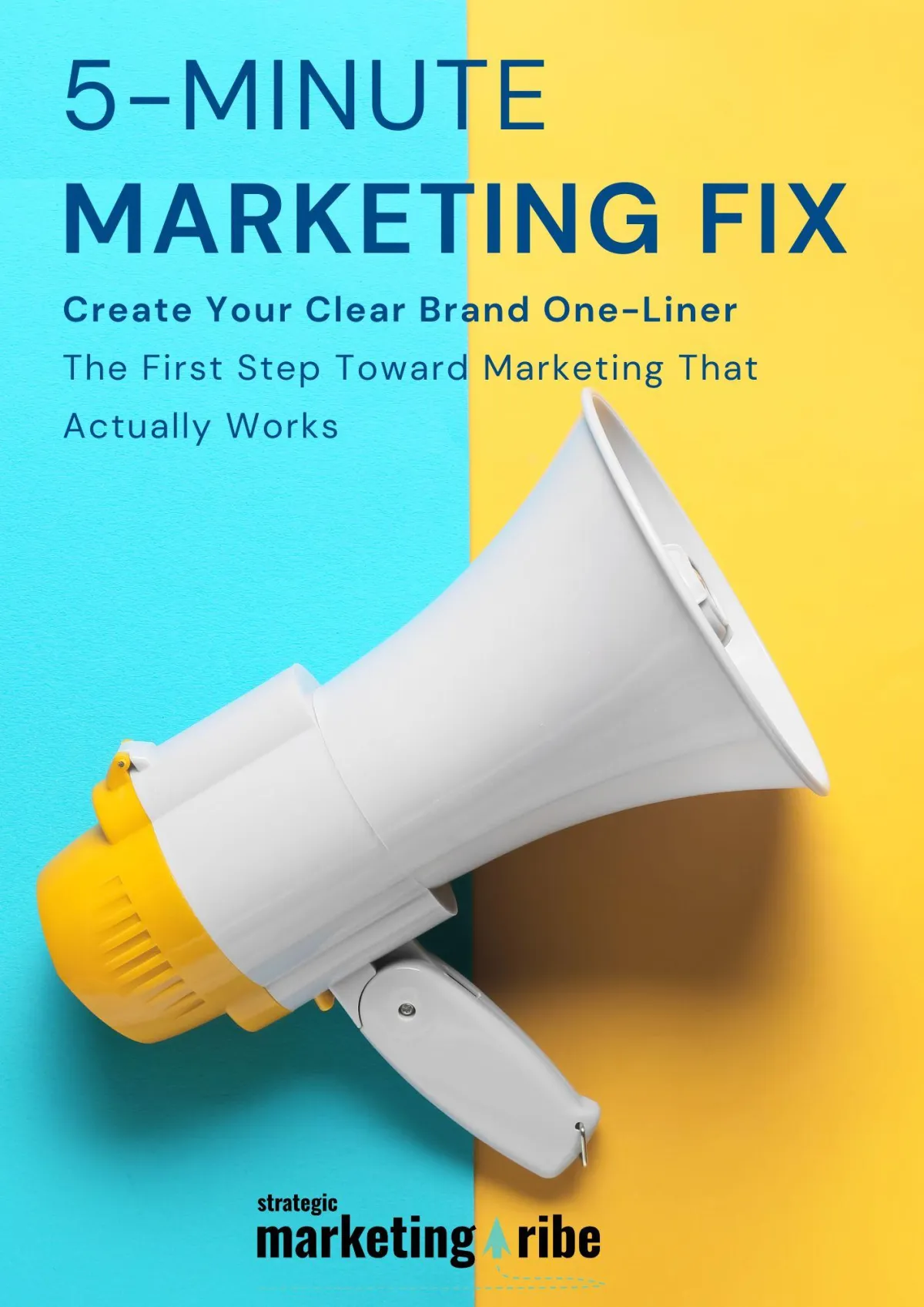NEWS, MEET STRATEGY
Real news, real insights – for small businesses who want to understand what’s happening and why it matters.

It’s Not Just You—AI Does Kinda Suck
By Vicky Sidler | Published 5 October 2025 at 12:00 GMT+2
If you feel like everyone promised AI would save time and make money but your experience looks more like “a robot just rewrote my blog post in the worst possible way,” you’re not alone.
According to Gartner and several industry leaders, generative AI is officially in its awkward teen phase. High hopes, lots of drama, and very few results you can take to the bank.
Welcome to the trough of disillusionment.
TL;DR:
Most generative AI pilots are failing to scale
Costs are skyrocketing without guaranteed ROI
Outputs remain unpredictable and can’t always be trusted
Usage-based pricing punishes experimentation
True results come from structure, not hype
👉 Need help getting your message right? Download the 5-Minute Marketing Fix
Table of Contents:
It’s Not Just You—AI Does Kinda Suck
If It Can’t Be Trusted, It Can’t Be Used:
Pilots Are Failing Because Foundations Are Missing:
Energy Bills and Budget Blows:
Pricing That Punishes Creativity:
Agents That Aren’t Ready for Prime Time:
The Value Is Still There—If You Work for It:
Start With What You Can Control:
1. AI Marketing Trust Gap Widens as Consumers Push Back
2. AI Automates 80 Percent of Marketing—What Now?
3. AI Search Distrust Grows—What Small Brands Should Do
4. ChatGPT Adds Parental Controls After Teen Tragedy
5. Meta’s AI Flirts With Kids—What That Tells Us About Trust
6. AI Customer Service Is Broken. Here’s What to Fix
7. Most People Can’t Spot AI Ads—Why That Matters for Your Brand
FAQs About Generative AI and Small Business Marketing
1. Why are so many generative AI pilots failing?
2. Can small businesses actually afford to use generative AI?
3. Why does AI keep getting things wrong—even after I correct it?
4. What is “AI hallucination” and why is it a problem?
5. Is generative AI safe to use in customer-facing content?
6. What are AI agents and should I be using them yet?
When Hype Meets Reality:
Remember when people said, “Just feed your data into AI and let the magic happen”? Turns out, magic isn’t scalable.
Small businesses that rushed to adopt AI are now asking a tough question: where are the results? Systems aren’t performing the same way twice. Costs are higher than expected. And in some cases, the output is completely wrong—but delivered with a straight face.
The result? A lot of leaders feel like they bought a self-driving car, only to learn they need to steer it manually, keep their foot on the brake, and watch out for hallucinations. Literally.
If It Can’t Be Trusted, It Can’t Be Used:
Generative AI works by predicting what comes next, not by checking facts. That means it might get your product description right today—and wildly wrong tomorrow. This inconsistency is fine for a brainstorming session, but not for anything public-facing or mission-critical.
A Gartner analyst put it simply: “You cannot automate something that you don’t trust.”
Which leads to the big issue: trust erosion. If your team stops relying on the tool, the tool stops being useful. And if your customers spot an obvious AI blunder in your content? There goes your credibility.
And we’ve all experienced this. One of my favorites is when you tell AI it got something wrong, and it politely apologises... then gives you the same wrong answer again. Even better is when it gaslights you—confidently explaining that it didn’t make a mistake, when it absolutely did. You end up in a debate with a robot, wondering if you're the problem. Spoiler: you’re not.
Pilots Are Failing Because Foundations Are Missing:
A working prototype is not a business tool. Many AI projects were rushed out with no checks, no fallback logic, and no way to scale under pressure. The second something goes wrong, the whole thing collapses.
The missing ingredient? Robust infrastructure.
Think of AI like a smart intern. It can help—but only if you supervise it, set clear rules, and give it proper tools. Skip that, and your bright idea turns into a slow-motion mess.
That’s not just theory. It’s already happening at scale.
Meta’s internal AI policy once allowed chatbots to flirt with kids—because technical disclaimers passed their checks, even when basic judgment didn’t. OpenAI only introduced parental controls after 16-year-old Adam Raine took his own life following prolonged conversations with ChatGPT about self-harm. These aren’t edge cases. They’re reminders that skipping safety to speed up deployment has consequences.
So if your own pilot project didn’t go as planned, that’s not failure. That’s feedback. But if you skip the part where you ask why it failed, then you’ve missed the lesson. And the cost of skipping that question isn’t always measured in budget. Sometimes, it’s measured in trust, time, or worse.
For small businesses, the fix isn’t more hype. It’s more structure. Start small. Build safety walls. Test everything. And remember that no amount of AI magic makes up for poor process.
Energy Bills and Budget Blows:
Here’s a fun surprise: running AI at scale costs more than you think. Some enterprises are spending millions just to keep their AI systems online. This is wild because one of the major selling points of AI has been how cheap it’s supposed to be.
I’m feeling it too, as I’m sure you are.
Every tool I use that has added AI now costs more. Subscriptions creep up. “Free” features become premium. Those extra charges don’t look huge at first, but they stack fast. I’m now spending considerably more each month just to keep the same tools running.
And that’s for tools that don’t even always work the way they’re supposed to.
While your bill might not hit seven figures, the principle still applies. If AI isn’t producing measurable value—like saving time, improving accuracy, or boosting conversions—it’s not earning its keep.
So before you get dazzled by fancy demos, look at the total cost. Training, integration, storage, rework, and higher subscriptions all add up fast.
Pricing That Punishes Creativity:
Most platforms now charge per successful output. Sounds fair, until you realise how often AI gets things wrong.
If your team needs 20 tries to get one decent answer, you're paying 20 times for one result. This discourages experimentation, slows down learning, and makes AI adoption feel more like a financial risk than a strategic move.
For small businesses, this creates a culture of caution. And that’s not where innovation thrives. I actually stopped using a few tools for this exact reason. I couldn’t afford to learn them.
Agents That Aren’t Ready for Prime Time:
AI agents—automated systems that act on AI decisions—are the latest buzzword. But here’s the problem: the brains behind them still hallucinate. So now you’ve got a confident robot making unpredictable decisions in real time.
AI Agents are broken, and so only 6 percent of e-commerce firms have rolled out agents. Not because they don’t want to, but because they can’t trust them yet.
Until the core systems become more stable, agent automation is a gamble. Not a strategy.
The Value Is Still There—If You Work for It:
Here’s where things get hopeful.
The fix isn’t throwing out AI. It’s setting it up better. That means using multiple tools together (called composite AI), testing thoroughly, building in safety nets, and measuring what matters.
Gartner and Planview both stress the same thing: the winners will be those who treat AI like a system, not a shortcut.
As a small business, you don’t need to wait for a perfect model. You need to build smartly around the imperfect ones we have now.
Start With What You Can Control:
If AI still feels mysterious, confusing, or expensive, that’s not your fault. The tech has outpaced the practical how-to. That’s why having a clear message, strong guardrails, and a structure around your marketing is more important than ever.
Start with something you can control. Your message.
Get my 5-Minute Marketing Fix to write one sentence that clarifies what you do and why people should trust you—even if your next ad was made by a robot.
Related Articles:
1. AI Marketing Trust Gap Widens as Consumers Push Back
You just read about businesses losing trust in AI. This article shows how customers are losing trust too—highlighting the real marketing gap between what businesses believe AI can do and what customers are willing to accept.
2. AI Automates 80 Percent of Marketing—What Now?
While this article covered what happens when AI flops, this one shows what happens when it “works”—and still causes new problems. A must-read if you're chasing automation without thinking through the human side.
3. AI Search Distrust Grows—What Small Brands Should Do
If you’re wondering what to do next, this post tackles AI search from the customer’s side and offers practical tips for small brands stuck between hype and hesitation.
4. ChatGPT Adds Parental Controls After Teen Tragedy
The article you just read touched on the tragic consequences of untested AI. This post gives the full story behind OpenAI’s safety updates after the death of 16-year-old Adam Raine.
5. Meta’s AI Flirts With Kids—What That Tells Us About Trust
This follow-up dives deeper into Meta’s internal policies that allowed AI to cross the line. It’s a clear example of why responsible deployment matters—especially for small teams who can’t afford that kind of fallout.
6. AI Customer Service Is Broken. Here’s What to Fix
Referenced in the main article, this piece uncovers why only 6 percent of companies are using AI agents. If your support system feels clunky, start here before making it worse with automation.
7. Most People Can’t Spot AI Ads—Why That Matters for Your Brand
Think AI errors are obvious? Think again. This article explains why nearly everyone misses AI-made ads and what that means for your brand’s transparency, credibility, and customer experience.
FAQs About Generative AI and Small Business Marketing
1. Why are so many generative AI pilots failing?
Most AI pilots fail because they’re rushed. Businesses skip the boring stuff like infrastructure, testing, and fallback plans. So when real-world data hits or the system outputs garbage, everything falls apart. It’s not the tech’s fault—it’s the process.
2. Can small businesses actually afford to use generative AI?
Not always. AI tools are getting more expensive, especially when platforms charge per output or move key features behind paid plans. If AI isn’t saving you time or increasing revenue, the extra cost probably isn’t worth it.
3. Why does AI keep getting things wrong—even after I correct it?
Because it’s not learning from your correction. Most tools aren’t self-improving in real time. They generate based on patterns, not facts, and sometimes repeat the same mistakes with confidence. That’s why you still need human review.
4. What is “AI hallucination” and why is it a problem?
AI hallucination is when the system confidently gives you a completely wrong answer. It’s a fancy way of saying “makes stuff up.” For casual tasks, that’s annoying. For customer service or financial info, it’s risky.
5. Is generative AI safe to use in customer-facing content?
Only if you’ve built in checks and controls. You need to review everything manually, test outputs across edge cases, and make sure the system isn’t saying something misleading. If you can’t do that, don’t put it in front of customers.
6. What are AI agents and should I be using them yet?
AI agents are tools that take action on your behalf, like answering emails or handling bookings. Most businesses aren’t using them yet because the underlying models are still too unpredictable. Trust is the issue, not the ambition.
7. How can I make sure my use of AI actually delivers ROI?
Track it. Be ruthless about what counts as value. Is it saving hours? Improving results? Generating leads? If you don’t measure that clearly, AI will just be another shiny expense that eats your budget.
8. What should I do before rolling out AI in my business?
Start by getting your message right. Then test tools in low-risk areas. Build guardrails. Use internal audits. Don’t roll out anything customer-facing unless you’ve validated it under pressure. And if you’re not sure what to say?
👉 Download the5-Minute Marketing Fix to clarify your message in one sentence.

Created with clarity (and coffee)







